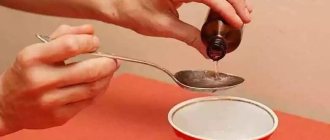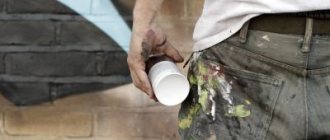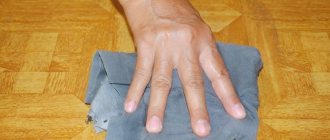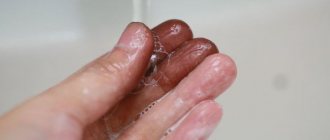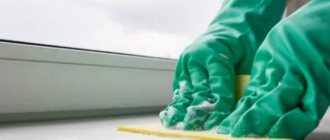It will take a lot of effort to remove drops of paint from a jacket.
To save outerwear, it is necessary to correctly determine the type of dyeing composition, the type of fabric, and also select an effective and safe product.
In this article we will tell you the safest way to remove paint from a jacket (leather, bolognese, etc.) at home.
How to remove a fresh stain?
Cleaning up a fresh blot is not difficult if you act quickly. The cleaning method depends on the type of paint:
alkyd - blot with a napkin with nail polish remover, acetone, lighter gasoline or any other solvent that is at hand;- oil - wash the damaged area with cold water and laundry soap or Fairy;
- water-based - treat the fabric with a cloth soaked in water or alcohol, clean with a soft brush;
- watercolor - rinse the painted area under running water, wash with any powder or laundry soap;
- stamp (mastic, ink) - cover the blot with salt, starch, baking soda until completely absorbed (until the substance stops coloring), then treat the stain with hot water, wash.
When removing a fresh stain:
- Do not rub or smudge the paint. So the area of damage will be much larger.
- The blot needs to be carefully blotted with a napkin or removed from the edges to the center.
- When using solvents, gasoline, or turpentine, first make a test in an inconspicuous area.
Immediately after detecting drops of paint, you need to take off your clothes and try to remove the contamination with a damp cloth or wash the area with cool water (not ice!). If stains remain, use solvents, improvised means, or ready-made stain removers.
How to remove paint from a jacket at home
Jackets can be made from different materials. To prevent a decrease in quality, the prepared product must be tested in an inconspicuous area. During the procedure, it is recommended to follow the following rules:
- Before removing the paint from the jacket, the product needs to be prepared.
- Laundry soap should be used before the paint stain has dried.
- At the last stage, the jacket should be treated with special means. When choosing a suitable composition, they are guided by the color of the product.
- To remove complex contaminants, safe products are first used. If there is no positive effect, aggressive compounds are used.
- If the stain has already dried, you will have to soften it before cleaning.
- Many substances that can help with paint stains are fire hazards. Therefore, they must be stored away from sources of fire and out of the reach of children.
If the paint has managed to get into the fibers, the chances of complete restoration of the fabric are quite small. In this case, the time spent will not be worth it. To avoid such problems, you must follow the recommendations on how to remove paint from a bologna, leather or synthetic jacket.
Rate this post
What is the safest way to remove old stains?
The choice of solvent for removing paint from outerwear depends on the complexity of the stain, its size, type of material, and type of contamination.
White Spirit
The solvent copes well with blots from any type of paint (oil, alkyd, acrylic). It is safe for fabric materials and does not discolor the design.
To remove a stain:
- The jacket must be placed on a flat, hard surface. Place a clean napkin under the damaged area on the wrong side.
- Apply a little solvent to a cotton swab.
- Gently wipe off the paint, trying not to go beyond the boundaries of the stain.
To speed up the cleansing process, you can first place a cotton pad soaked in white spirit on the stain for 10–15 minutes.
After treatment, the jacket should be washed in the usual way with the addition of fabric softener. Similarly, you can use nail polish remover or regular acetone.
Gasoline, turpentine, kerosene
Effective in removing fresh or dried stains.
The instructions are as follows:
- a little product should be applied to the blot;
- leave for 10 minutes to soak the paint;
- Wipe off with a cotton pad or soft brush.
To remove complex, old stains, use a mixture of gasoline, kerosene and turpentine in equal quantities. Using a napkin soaked in a reinforced composition, blot the damaged area until the stains are completely removed.
Only purified substances can be used. They are safe for fabric and do not leave streaks.
Medical alcohol
An undiluted product can easily clean a jacket made of synthetic material or leather.
The algorithm of actions is standard:
- Place a cloth soaked in alcohol on the stain and leave for 15 minutes.
- Clean.
- Rinse the area with running water. Wash clothes completely.
Alcohol removes fresh marks well. It doesn't cope well with dried stains, especially on jackets made from natural materials.
Warm alcohol can be used in the first stage of comprehensive cleansing. It softens the base of coloring compounds and helps solvents or other means remove stains from the jacket.
Laundry soap and baking soda
Thick foam will help remove traces of water-based emulsion from any type of outerwear:
- The damaged area should be thickly soaped with laundry soap.
- Leave for half an hour.
- Launder. Use a brush to gently clean the painted areas.
- Rinse. Wash as usual.
The soap is safe for any outerwear, does not discolor, and does not leave streaks.
To clean heavily soiled jackets that are not afraid of exposure to very high temperatures, you can use a mixture of soap shavings, baking soda and hot water (5 tablespoons per 1 liter):
- clothes in a soap-soda mixture must be boiled for 15 minutes;
- leave to soak until cool;
- brush;
- rinse, wash in washing machine.
Dishwashing liquid
Fairy can be used as an express product for quickly removing fresh drops from oil, water-based, acrylic, and watercolor paint.
A little remedy:
- Apply to fabric using a toothbrush;
- rub gently;
- wash clothes with added fabric softener.
To remove water-based paint from a leather jacket:
- The top layer of the blot must be carefully removed with a knife or blade.
- Foam 1 tbsp in 200 ml of water. l. Fairy.
- Using a sponge, apply thick foam to the painted area.
- When the mark disappears, wipe the skin dry. Apply any softening cream (cosmetic hand cream, children's cream, special shoe cream).
As the coloring composition dries, the effectiveness of the product decreases. It will not be able to remove old drops from oil or acrylic paint.
How to clean with vegetable oil?
Suitable for removing fresh stains from bolognese or leather jackets:
- Apply a little sunflower oil to a cotton swab or soft napkin.
- Treat the stained area, periodically replacing the cotton wool with fresh one, until the stain disappears.
- Wipe with a clean cloth moistened with warm water. Dry. You can apply a special coloring cream selected by color or shoe wax to a leather product. Fabric jacket - wash.
If the paint has already dried, you can use baking soda to enhance the effect:
- prepare a thick paste (for 1 tbsp. oil you need about 3 tbsp. soda);
- apply to the stain, leave for 15 minutes;
- clean with a brush, rinse with warm water.
Oil should not be used for jackets made from natural fabrics.
Recommendations and prohibitions
To effectively wipe off any type of dye from the skin, the following must be considered:
you need to try to remove the mark as quickly as possible before the dye dries;- Do not etch paint stains on your face with solvents;
- it is necessary to wipe off dried traces of oil paint on hands and feet with solvents;
- before removing dried paint from the skin, you must first soften it with warm water for 10-20 minutes;
- It is recommended to wipe off any fresh paint with warm soapy water;
- You should use pumice stone and a toothbrush when scrubbing away dyes.
After any treatment of the skin with various means, it is necessary to wash it thoroughly with warm water and soap, and then use a moisturizer. It will soften the skin and prevent irritation from occurring on it.
Patience and following the recommendations will help you remove dye from outer clothing:
- Work with solvents must be carried out with the window open and using protective equipment. This will avoid poisoning by vapors of acetone and similar liquids.
- Any product must first be applied to an inconspicuous area of the product. If the reaction is negative, you should choose a different cleaning method.
- Fresh dirt can be removed faster than dirt that has already dried. Therefore, if a dye gets on the fabric, you should not hesitate to save it: you must quickly wash the stain with oil or gasoline. Traces of these products can be removed later.
Choosing a product for different materials
When starting to remove stains, you need to take into account the type of fabric from which the outerwear is made.
Leather clothing (natural or artificial)
Fresh drops needed:
- Blot with a paper napkin.
- Rub the damaged area with laundry soap or Fairy.
It's better to use a toothbrush. The bristles will help remove traces of pigment from the pores or natural folds of the material. - Remove any remaining foam with a damp cloth.
To erase dried stains you will need a solvent, oil or alcohol. Hot water or steam cannot be used.
Bologna
The measures depend on how long ago the item was soiled:
- You can try to wash off the drops that have just splashed with a strong stream of running water;
- fresh marks - treat with warmed medical alcohol, vodka or ammonia;
- dried - with turpentine, kerosene or acetone.
After cleaning, clothes must be washed in a washing machine or by hand with powder and fabric softener to remove unpleasant odors and stains from solvents.
Polyester
Any means that corrode color pigments is safe for artificial materials.
If a stain is detected, you need to:
- Remove the top layer with salt, baking soda, or scrape off with a knife or blade.
- Wash the damaged area with soap or Fairy.
- Blot the dye absorbed into the fabric with a napkin containing solvent, gasoline, or acetone.
Dried stains from oil paint should be softened with alcohol lotion before washing.
Methods for cleaning clothes from artistic paints
Creativity is a huge part of many people's lives. Professional artists, amateurs or children create hand-made masterpieces.
But this activity has one big disadvantage - constant contamination of clothes with paints; rarely does anyone manage to avoid the appearance of stains. All methods of cleaning things from artistic paints can be divided into several types. It all depends on the source of pollution.
- Watercolor and gouache.
Both types of paints are water-soluble; they can be easily removed from clothes even with cold water. If this does not help, then washing powder or stain remover will be used. Almost 100 percent of the time they are watercolor and disappear after washing. - Tempera
is a fairly common paint that can remove stains by biting. This is very simple to do: moisten a clean white rag with vinegar and apply to the stain, blot slightly. If this does not help, then there is only one way out - to remove the paint from the clothes using a stain remover. - Acrylic stains on any fabric can be easily removed with medical alcohol.
To do this, you need to moisten a cotton swab with alcohol and rub the stain.
Do not wet stains from acrylic paints with hot water, otherwise the stain will be embedded even deeper into the product and will be almost impossible to remove even with the most potent means.
Features of cleansing depending on color
When choosing how to remove paint, you need to take into account not only the type, but also the color of the fabric.
White
When processing such clothing, care must be taken, because... Solvents, benzene, or turpentine may leave yellow or gray streaks.
To remove colored droplets, it is recommended to use ammonia, heated alcohol or hydrogen peroxide. A blot from stamp paint, watercolor paint, or gouache can be sprinkled with baking soda, salt, or crushed chalk.
If this does not help, mild chlorine-containing or optical brighteners are acceptable . At the same time, you should not wash a white down jacket in “Whiteness”. The fabric will quickly turn yellow.
Black
To clean dark material, purified gasoline, turpentine or acetone are suitable. Fresh stains can be removed with laundry soap.
Bleach, baking soda, alcohol or solvents will leave bleached areas and should not be used.
Basic cleaning rules
Regardless of the material the jacket is made of, when removing paint stains, you should adhere to the following basic rules:
- Before you wash a stain, you first need to check how the solvent behaves. It is better to do this in an inconspicuous place of outerwear.
- It is important to use gloves to avoid damaging the skin with aggressive chemical compounds.
- You should wear a respirator if stains on clothing are removed with toxic solvents.
- If acetone is used to remove traces, you need to ventilate the room.
You should start removing paint stains as quickly as possible. A fresh stain is much easier to remove than an old stain.
When handling a jacket with cleaning agents, you should use gloves.
What to do if the type of dye is unknown?
It is not always possible to determine which dye stain remains on the jacket.
In this case, you should first try safe cleansing methods:
Carefully remove the drop with a hard tool (knife, scissors, nail file) before it dries.
You need to act carefully, collecting paint from the edge to the center, trying not to damage the material.- Wash the stained area with cool water and laundry soap or dish soap.
- Use a stain remover for colored or white laundry, depending on the color of the jacket.
You shouldn’t try to clean expensive jackets made from capricious material yourself. It would be safer to go to a dry cleaner and entrust paint removal to professionals.

